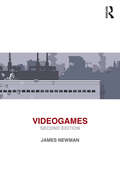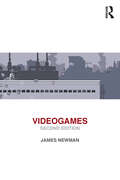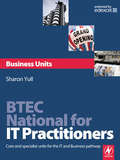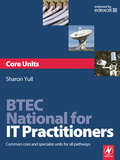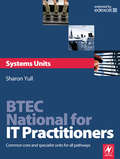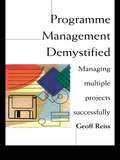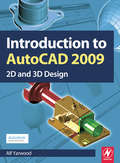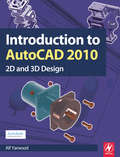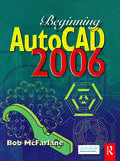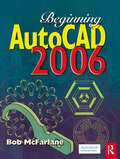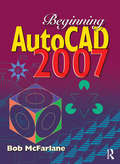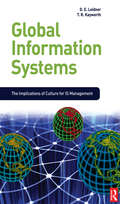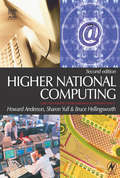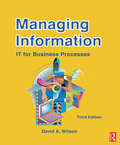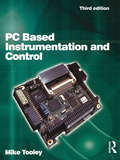- Table View
- List View
Videogames
by James NewmanIn the few decades since they first blipped their way onto television screens, videogames have become one of the most culturally, socially and economically significant media forms. Newman’s volume considers how we might approach videogames as media texts to be read, experiences to be played and played with, systems and simulations to be decoded and interrogated, and performances to be captured, codified and preserved. The updated second edition examines the emergence of new platforms as well as changing patterns of production and consumption in its analysis of Wii, Xbox 360, PS3 and mobile gaming. The new final chapter explores recent developments in games scholarship with particular focus falling on the study of gameplay as socially situated, ‘lived experience’, and on strategies for game history, heritage and preservation. In drawing attention to the fragility and ephemerality of hardware, software and gameplay, this new edition encourages readers and players not only to consider how games might be studied but also what can, will and should be left behind for the next generation of games researchers.
Videogames
by James NewmanIn the few decades since they first blipped their way onto television screens, videogames have become one of the most culturally, socially and economically significant media forms. Newman’s volume considers how we might approach videogames as media texts to be read, experiences to be played and played with, systems and simulations to be decoded and interrogated, and performances to be captured, codified and preserved. The updated second edition examines the emergence of new platforms as well as changing patterns of production and consumption in its analysis of Wii, Xbox 360, PS3 and mobile gaming. The new final chapter explores recent developments in games scholarship with particular focus falling on the study of gameplay as socially situated, ‘lived experience’, and on strategies for game history, heritage and preservation. In drawing attention to the fragility and ephemerality of hardware, software and gameplay, this new edition encourages readers and players not only to consider how games might be studied but also what can, will and should be left behind for the next generation of games researchers.
BTEC National for IT Practitioners: Business units
by Sharon YullBTEC National for IT Practitioners: Business Units has been written specifically to cover the business pathway of the BTEC National specifications. This book caters for one of the most popular pathways in the BTEC National specifications, bringing together all the key specialist units for students who have chosen the business route, including the core units specific to this pathway that aren't covered in the core unit book. When used alongside its companions for the core units and systems support pathways, this series delivers the most accessible and usable student textbooks available for the BTEC National. Units covered: Unit 1 – Exploring Business Activity Unit 4 – IT ProjectUnit 2 – Investigating Business Resources Unit 34 – E CommerceUnit 3 – Introduction to Marketing Unit 35 – Impact of the Use of IT on Business SystemsUnit 4 – IT ProjectUnit 34 – E CommerceUnit 35 – Impact of the Use of IT on Business SystemsWritten by an experienced tutor, each unit is illustrated with assessment activities, end-of-chapter questions, case studies and practical exercises. The result is a clear, straightforward textbook that encourages independent study and acts as a reference to various topics within the qualification.
BTEC National for IT Practitioners: Business units
by Sharon YullBTEC National for IT Practitioners: Business Units has been written specifically to cover the business pathway of the BTEC National specifications. This book caters for one of the most popular pathways in the BTEC National specifications, bringing together all the key specialist units for students who have chosen the business route, including the core units specific to this pathway that aren't covered in the core unit book. When used alongside its companions for the core units and systems support pathways, this series delivers the most accessible and usable student textbooks available for the BTEC National. Units covered: Unit 1 – Exploring Business Activity Unit 4 – IT ProjectUnit 2 – Investigating Business Resources Unit 34 – E CommerceUnit 3 – Introduction to Marketing Unit 35 – Impact of the Use of IT on Business SystemsUnit 4 – IT ProjectUnit 34 – E CommerceUnit 35 – Impact of the Use of IT on Business SystemsWritten by an experienced tutor, each unit is illustrated with assessment activities, end-of-chapter questions, case studies and practical exercises. The result is a clear, straightforward textbook that encourages independent study and acts as a reference to various topics within the qualification.
BTEC National for IT Practitioners: Core units
by Sharon YullBTEC National for IT Practitioners has been written specifically to cover the compulsory core units and selected specialist units of the BTEC National specifications. This book provides core unit coverage for students following all courses within the new scheme – National Awards, National Certificates and National Diplomas. When used alongside its companions for the business and systems support pathways, this series delivers the most accessible and usable student textbooks available for the BTEC National.Units covered: Unit 1 – Communication and Employability Skills Unit 8 – Communication TechnologiesUnit 2 – Computer Systems Unit 15 – Organizational Systems SecurityUnit 3 – Information Systems Unit 18 – Principles of Software Design and DevelopmentUnit 7 – IT Systems Analysis and Design Unit 21 – Website Production and Management Written by an experienced tutor, each unit is illustrated with assessment activities, end-of-chapter questions, case studies and practical exercises. The result is a clear, straightforward textbook that encourages independent study and acts as a reference to various topics within the qualification.
BTEC National for IT Practitioners: Core units
by Sharon YullBTEC National for IT Practitioners has been written specifically to cover the compulsory core units and selected specialist units of the BTEC National specifications. This book provides core unit coverage for students following all courses within the new scheme – National Awards, National Certificates and National Diplomas. When used alongside its companions for the business and systems support pathways, this series delivers the most accessible and usable student textbooks available for the BTEC National.Units covered: Unit 1 – Communication and Employability Skills Unit 8 – Communication TechnologiesUnit 2 – Computer Systems Unit 15 – Organizational Systems SecurityUnit 3 – Information Systems Unit 18 – Principles of Software Design and DevelopmentUnit 7 – IT Systems Analysis and Design Unit 21 – Website Production and Management Written by an experienced tutor, each unit is illustrated with assessment activities, end-of-chapter questions, case studies and practical exercises. The result is a clear, straightforward textbook that encourages independent study and acts as a reference to various topics within the qualification.
BTEC National for IT Practitioners: Systems units
by Sharon YullBTEC National for IT Practitioners: Systems Units has been written specifically to cover the systems pathway of the BTEC National specifications.This book caters for one of the most popular pathways in the BTEC National specifications, bringing together all the key specialist units for students who have chosen the systems route, including the core units specific to this pathway that aren't covered in the core unit book. When used alongside its companions for the core units and business pathways, this series delivers the most accessible and usable student textbooks available for the BTEC National.Units covered: Unit 11 – Data Analysis and Design Unit 22 – Network ManagementUnit 13 – Human Computer Interaction Unit 28 – IT Technical SupportUnit 16 – Maintaining Computer Systems Unit 29 – IT Systems Troubleshooting and Repair Written by an experienced tutor, each unit is illustrated with assessment activities, end-of-chapter questions, case studies and practical exercises. The result is a clear, straightforward textbook that encourages independent study and acts as a reference to various topics within the qualification.
BTEC National for IT Practitioners: Systems units
by Sharon YullBTEC National for IT Practitioners: Systems Units has been written specifically to cover the systems pathway of the BTEC National specifications.This book caters for one of the most popular pathways in the BTEC National specifications, bringing together all the key specialist units for students who have chosen the systems route, including the core units specific to this pathway that aren't covered in the core unit book. When used alongside its companions for the core units and business pathways, this series delivers the most accessible and usable student textbooks available for the BTEC National.Units covered: Unit 11 – Data Analysis and Design Unit 22 – Network ManagementUnit 13 – Human Computer Interaction Unit 28 – IT Technical SupportUnit 16 – Maintaining Computer Systems Unit 29 – IT Systems Troubleshooting and Repair Written by an experienced tutor, each unit is illustrated with assessment activities, end-of-chapter questions, case studies and practical exercises. The result is a clear, straightforward textbook that encourages independent study and acts as a reference to various topics within the qualification.
Portfolio and Programme Management Demystified: Managing Multiple Projects Successfully (PDF)
by Geoff ReissThis book provides the perfect companion to Geoff Reiss's Project Management Demystified and presents the techniques of multi-project management in a lively, approachable manner. It covers budgets, cost control, planning problems and matrix management formulae. Drawing on a wide range of case histories and lively examples, it tackles organisational issues and the multi-project conflicts that often arise.
Introduction to AutoCAD 2009
by Alf YarwoodAlf Yarwood provides a practical, structured course of work matched to the latest release of AutoCAD. After introducing first principles and the creation of 2D technical drawings, he goes on to demonstrate the construction of 3D solid and surface model drawings and rendering. All the new features of the 2009 software release are taken into account and the increasing emphasis on 3D solid modelling in the software is reflected in the book. The 2D chapters are also suitable for those learning how to use AutoCAD LT 2009.Suitable for all new users of AutoCAD, this book is particularly applicable to vocational and introductory level undergraduate courses in engineering and construction. It is an ideal textbook for the City & Guilds Computer Aided Design and Engineering qualifications (4353 and 2303)and the relevant CAD units of BTEC National and BTEC Higher National Engineering and Construction schemes from Edexcel.A free companion website is available at http://books.elsevier.com/companions/9780750689830 and features: Worked solutions and AutoCAD drawing files of stages and results for the exercises in the bookFurther exercises and multiple-choice questions with answers.
Introduction to AutoCAD 2009
by Alf YarwoodAlf Yarwood provides a practical, structured course of work matched to the latest release of AutoCAD. After introducing first principles and the creation of 2D technical drawings, he goes on to demonstrate the construction of 3D solid and surface model drawings and rendering. All the new features of the 2009 software release are taken into account and the increasing emphasis on 3D solid modelling in the software is reflected in the book. The 2D chapters are also suitable for those learning how to use AutoCAD LT 2009.Suitable for all new users of AutoCAD, this book is particularly applicable to vocational and introductory level undergraduate courses in engineering and construction. It is an ideal textbook for the City & Guilds Computer Aided Design and Engineering qualifications (4353 and 2303)and the relevant CAD units of BTEC National and BTEC Higher National Engineering and Construction schemes from Edexcel.A free companion website is available at http://books.elsevier.com/companions/9780750689830 and features: Worked solutions and AutoCAD drawing files of stages and results for the exercises in the bookFurther exercises and multiple-choice questions with answers.
Introduction to AutoCAD 2010
by Alf YarwoodAlf Yarwood provides a practical, structured course of work matched to the latest release of AutoCAD. After introducing first principles and the creation of 2D technical drawings, he goes on to demonstrate the construction of 3D solid drawings, surface model drawings and rendering. All the new features of the 2010 software release are taken into account and the increasing emphasis on 3D solid modelling in the software is reflected in the book. The 2D chapters are also suitable for those learning how to use AutoCAD LT 2010.Suitable for all new users of AutoCAD, this book is particularly applicable to vocational and introductory level undergraduate courses in engineering and construction. Further Education students in the UK will find this an ideal textbook to cater for the City & Guilds 4353 and 2303 qualifications and the relevant CAD units of BTEC National and BTEC Higher National Engineering and Construction schemes from Edexcel. Many Foundation Degrees also contain CAD modules for which this book can be of use.Readers will also be able to visit a free companion website at http://books.elsevier.com/companions/9781856178686, where they will find worked solutions and AutoCAD drawing files of stages and results for the exercises in the book, as well as further exercises and multiple-choice questions with answers.
Introduction to AutoCAD 2010
by Alf YarwoodAlf Yarwood provides a practical, structured course of work matched to the latest release of AutoCAD. After introducing first principles and the creation of 2D technical drawings, he goes on to demonstrate the construction of 3D solid drawings, surface model drawings and rendering. All the new features of the 2010 software release are taken into account and the increasing emphasis on 3D solid modelling in the software is reflected in the book. The 2D chapters are also suitable for those learning how to use AutoCAD LT 2010.Suitable for all new users of AutoCAD, this book is particularly applicable to vocational and introductory level undergraduate courses in engineering and construction. Further Education students in the UK will find this an ideal textbook to cater for the City & Guilds 4353 and 2303 qualifications and the relevant CAD units of BTEC National and BTEC Higher National Engineering and Construction schemes from Edexcel. Many Foundation Degrees also contain CAD modules for which this book can be of use.Readers will also be able to visit a free companion website at http://books.elsevier.com/companions/9781856178686, where they will find worked solutions and AutoCAD drawing files of stages and results for the exercises in the book, as well as further exercises and multiple-choice questions with answers.
Beginning AutoCAD 2006
by Bob McFarlaneBeginning AutoCAD 2006 is a course based on learning and practising the essentials of 2D drawing using AutoCAD. Bob McFarlane’s hands-on approach is uniquely suited to independent learning and use on courses. The focus on 2D drawing in one book ensures the reader gets a thorough grounding in the subject, with a greater depth of coverage than tends to be available from general introductions to AutoCAD. As a result, this book provides a true, step-by-step, detailed exploration of the AutoCAD functions required at each stage of producing a 2D drawing – an approach often not found in the many software reference guides available.The emphasis on learning through doing makes this book ideal for anyone involved in engineering, construction or architecture – where the focus is on productivity and practical skills. The author has also matched the coverage to the requirements of City and Guilds, Edexcel (BTEC) and SQA syllabuses.New features in AutoCAD 2006 are covered in this book including: DYN (dynamic input showing coordinate position and lengths – an important new feature of the latest AutoCAD software), as well as new commands in the Modify and Dimension tool set. The result is a useful refresher course for anyone using AutoCAD at this level, and those upgrading to the new software release. The course is also designed to be fully relevant to anyone using other recent releases, including AutoCAD 2005.
Beginning AutoCAD 2006
by Bob McFarlaneBeginning AutoCAD 2006 is a course based on learning and practising the essentials of 2D drawing using AutoCAD. Bob McFarlane’s hands-on approach is uniquely suited to independent learning and use on courses. The focus on 2D drawing in one book ensures the reader gets a thorough grounding in the subject, with a greater depth of coverage than tends to be available from general introductions to AutoCAD. As a result, this book provides a true, step-by-step, detailed exploration of the AutoCAD functions required at each stage of producing a 2D drawing – an approach often not found in the many software reference guides available.The emphasis on learning through doing makes this book ideal for anyone involved in engineering, construction or architecture – where the focus is on productivity and practical skills. The author has also matched the coverage to the requirements of City and Guilds, Edexcel (BTEC) and SQA syllabuses.New features in AutoCAD 2006 are covered in this book including: DYN (dynamic input showing coordinate position and lengths – an important new feature of the latest AutoCAD software), as well as new commands in the Modify and Dimension tool set. The result is a useful refresher course for anyone using AutoCAD at this level, and those upgrading to the new software release. The course is also designed to be fully relevant to anyone using other recent releases, including AutoCAD 2005.
Beginning AutoCAD 2007
by Bob McFarlaneBeginning AutoCAD 2007 is a course based on learning and practising the essentials of 2D drawing using AutoCAD. Bob McFarlane's hands-on approach is uniquely suited to independent learning and use on courses. The focus on 2D drawing in one book ensures the reader gets a thorough grounding in the subject, with a greater depth of coverage than tends to be available from general introductions to AutoCAD. As a result, this book provides a true, step-by-step, detailed exploration of the AutoCAD functions required at each stage of producing a 2D drawing - an approach often not found in the many software reference guides available.The emphasis on learning through doing makes this book ideal for anyone involved in engineering, construction or architecture - where the focus is on productivity and practical skills. The author has also matched the coverage to the requirements of City and Guilds, Edexcel (BTEC) and SQA syllabuses.The following new features in AutoCAD 2007 are covered in this book:* Create: Using enhanced commands and draughting tools to create all types of content* Manage: Using the Sheet Set Manager and Attribute Extraction to manage data and information* Produce: Using dynamic blocks, dynamic input and selection preview to increase productivity* Share: Using e-transmit, publish to the web and PDF files to share informationPlus, a new companion website features AutoCAD files for selected activities for students to work with.The result is a useful refresher course for anyone using AutoCAD at this level, and those upgrading to the new software release. The course is also designed to be fully relevant to anyone using other recent releases, including AutoCAD 2006.ABOUT THE AUTHOR Bob McFarlane has been writing books on AutoCAD for over 10 years.
Beginning AutoCAD 2007
by Bob McFarlaneBeginning AutoCAD 2007 is a course based on learning and practising the essentials of 2D drawing using AutoCAD. Bob McFarlane's hands-on approach is uniquely suited to independent learning and use on courses. The focus on 2D drawing in one book ensures the reader gets a thorough grounding in the subject, with a greater depth of coverage than tends to be available from general introductions to AutoCAD. As a result, this book provides a true, step-by-step, detailed exploration of the AutoCAD functions required at each stage of producing a 2D drawing - an approach often not found in the many software reference guides available.The emphasis on learning through doing makes this book ideal for anyone involved in engineering, construction or architecture - where the focus is on productivity and practical skills. The author has also matched the coverage to the requirements of City and Guilds, Edexcel (BTEC) and SQA syllabuses.The following new features in AutoCAD 2007 are covered in this book:* Create: Using enhanced commands and draughting tools to create all types of content* Manage: Using the Sheet Set Manager and Attribute Extraction to manage data and information* Produce: Using dynamic blocks, dynamic input and selection preview to increase productivity* Share: Using e-transmit, publish to the web and PDF files to share informationPlus, a new companion website features AutoCAD files for selected activities for students to work with.The result is a useful refresher course for anyone using AutoCAD at this level, and those upgrading to the new software release. The course is also designed to be fully relevant to anyone using other recent releases, including AutoCAD 2006.ABOUT THE AUTHOR Bob McFarlane has been writing books on AutoCAD for over 10 years.
Global Information Systems
by Dorothy E Leidner Tim KayworthInformation technology has had a major impact on individuals, organizations and society over the past 50 years. There are few organizations that can afford to ignore IT and few individuals who would prefer to be without it. As managerial tasks become more complex, so the nature of the required information systems (IS) changes - from structured, routine support to ad hoc, complex enquiries at the highest levels of management. Global Information Systems aims to present the many complex and inter-related issues associated with culture in the management of information systems. The editors have selected a wide range of contemporary articles from leading experts in North America and Europe that represent a wide variety of different national and cultural environments. They offer valid explanations for, rather than simply pointing out cultural differences in articles that cover a variety of national cultures, including: China, Egypt, Finland, Hong Kong, Hungary, India, Jamaica, Peru South Korea, Kuwait, Mexico, Singapore, Sweden, the United Arab Emirate, the UK, and the US.
Global Information Systems
by Dorothy E Leidner Tim KayworthInformation technology has had a major impact on individuals, organizations and society over the past 50 years. There are few organizations that can afford to ignore IT and few individuals who would prefer to be without it. As managerial tasks become more complex, so the nature of the required information systems (IS) changes - from structured, routine support to ad hoc, complex enquiries at the highest levels of management. Global Information Systems aims to present the many complex and inter-related issues associated with culture in the management of information systems. The editors have selected a wide range of contemporary articles from leading experts in North America and Europe that represent a wide variety of different national and cultural environments. They offer valid explanations for, rather than simply pointing out cultural differences in articles that cover a variety of national cultures, including: China, Egypt, Finland, Hong Kong, Hungary, India, Jamaica, Peru South Korea, Kuwait, Mexico, Singapore, Sweden, the United Arab Emirate, the UK, and the US.
Higher National Computing
by Howard Anderson Sharon Yull Bruce HellingsworthHigher National Computing 2e is a new edition of this extremely successful course book, updated specifically to cover the compulsory core units of the 2003 BTEC Higher National Computing schemes. Full coverage is given of the four core units for HNC, the two additional core units required at HND, and the Core Specialist Unit 'Quality Systems', common to both certificate and diploma level.Students following the HNC and HND courses will find this book essential reading, as it covers the core material they will be following through the duration of their course. Knowledge-check questions and activities are included throughout, resulting in a clear and straightforward text which encourages independent study.Like the syllabus itself, this book is ideal for students progressing to HNC / HND from GNVQs, as well as A-Level and BTEC National, with content designed to cover the requirements of students following General Computing, Software Engineering and Business IT courses.
Higher National Computing
by Howard Anderson Sharon Yull Bruce HellingsworthHigher National Computing 2e is a new edition of this extremely successful course book, updated specifically to cover the compulsory core units of the 2003 BTEC Higher National Computing schemes. Full coverage is given of the four core units for HNC, the two additional core units required at HND, and the Core Specialist Unit 'Quality Systems', common to both certificate and diploma level.Students following the HNC and HND courses will find this book essential reading, as it covers the core material they will be following through the duration of their course. Knowledge-check questions and activities are included throughout, resulting in a clear and straightforward text which encourages independent study.Like the syllabus itself, this book is ideal for students progressing to HNC / HND from GNVQs, as well as A-Level and BTEC National, with content designed to cover the requirements of students following General Computing, Software Engineering and Business IT courses.
Managing Information
by David A Wilson'Managing Information' describes how successful organizations make best use of information and knowledge - the key resources in business. It explains why information technology is essential for the management of business processes, and should be central to any business strategy. This updated edition provides a compelling rationale for organizations to use appropriate systems, and for individuals to acquire the skills to manage and use the systems. It describes how computer systems continue to evolve to meet business needs, and provides examples and exercises to help readers develop their skills. There is a new emphasis on the Internet - how to use it to keep up to date with the latest business issues, and how teams can communicate and collaborate with intranets.All of the most common sub-systems are described and explained, including Enterprise Resource Planning (ERP), Business-to-Business (B2B), Business-to-Consumer (B2C), Supply Chain Management (SCM), Customer Relationship Management (CRM) and Enterprise Application Integration (EAI). The latest developments are described, including services available through the Internet from Application Service Providers (ASP), collaborative commerce and Business Process Management (BPM).There are introductory and more advanced computer exercises to consolidate learning and demonstrate how to acquire, store, organize and present information, using Word, Excel, PowerPoint and Explorer.
Managing Information
by David A Wilson'Managing Information' describes how successful organizations make best use of information and knowledge - the key resources in business. It explains why information technology is essential for the management of business processes, and should be central to any business strategy. This updated edition provides a compelling rationale for organizations to use appropriate systems, and for individuals to acquire the skills to manage and use the systems. It describes how computer systems continue to evolve to meet business needs, and provides examples and exercises to help readers develop their skills. There is a new emphasis on the Internet - how to use it to keep up to date with the latest business issues, and how teams can communicate and collaborate with intranets.All of the most common sub-systems are described and explained, including Enterprise Resource Planning (ERP), Business-to-Business (B2B), Business-to-Consumer (B2C), Supply Chain Management (SCM), Customer Relationship Management (CRM) and Enterprise Application Integration (EAI). The latest developments are described, including services available through the Internet from Application Service Providers (ASP), collaborative commerce and Business Process Management (BPM).There are introductory and more advanced computer exercises to consolidate learning and demonstrate how to acquire, store, organize and present information, using Word, Excel, PowerPoint and Explorer.
PC Based Instrumentation and Control
by Mike TooleyPC Based Instrumentation and Control is a guide to implementing computer control, instrumentation and data acquisition using a standard PC and some of the most popular computer languages.Numerous examples of configurations and working circuits, as well as representative software, make this a practical, hands-on guide to implementing PC-based testing and calibration systems and increasing efficiency without compromising quality or reliability. Guidance is given on modifying the circuits and software routines to meet the reader's specific needs.The third edition includes updated coverage of PC hardware and bus systems, a new chapter on virtual instruments and an introduction to programming and software development in a modern 32-bit environment. Additional examples have been included, with source code and executables available for download from the companion website www.key2control.com.
PC Based Instrumentation and Control
by Mike TooleyPC Based Instrumentation and Control is a guide to implementing computer control, instrumentation and data acquisition using a standard PC and some of the most popular computer languages.Numerous examples of configurations and working circuits, as well as representative software, make this a practical, hands-on guide to implementing PC-based testing and calibration systems and increasing efficiency without compromising quality or reliability. Guidance is given on modifying the circuits and software routines to meet the reader's specific needs.The third edition includes updated coverage of PC hardware and bus systems, a new chapter on virtual instruments and an introduction to programming and software development in a modern 32-bit environment. Additional examples have been included, with source code and executables available for download from the companion website www.key2control.com.
